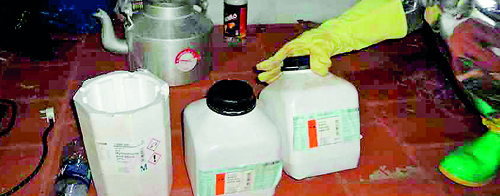Sunday Times 2
India’s meth addiction grows as criminals tap chemical hub
View(s):MUMBAI, (AFP) – The teenager sits quietly in a Mumbai rehab clinic, a victim of India’s emerging fad for the drug crystal meth, which experts say is spurred by loopholes in the country’s giant chemical industry.
“It made me feel powerful,” said the 19-year-old undergraduate student, who began taking the drug with friends at college last year and was soon snorting up to 40 lines of the dangerous stimulant in a single session.

This handout photograph released by the Narcotics Control Bureau (NCB) on July 15, 2014 shows a member of the NCB posing with materials on the rooftop of a house during a 'meth lab' raid in the Sivaganaga District in southern Tamil Nadu. AFP
“We would just sit and keep doing it,” he told AFP, declining to be named as he recovers from his addiction.
While meth has long been a scourge across east and southeast Asia, staff at the rehab centre in Mumbai’s Masina Hospital say it only surfaced as a concern in the city in the past 18 to 24 months.
“Before that we’d never heard of it. Of late we had a small (addicted) boy aged 14 come in and he opened our eyes,” said Ali Gabhrani, director of the centre.
India is home to one of the world’s biggest chemical industries and is a major source of key meth ingredients ephedrine and pseudoephedrine, which are both legally used in medication such as decongestants.
Along with China, India is the most commonly cited origin of illicit shipments of these precursor drugs destined for meth labs abroad, particularly in neighbouring Myanmar but as far afield as central America and Africa, according to the UN Office on Drugs and Crime.
But concern is growing about the clandestine manufacture and consumption of meth within India itself, with Mumbai’s Anti-Terrorism Squad (ATS) in recent weeks taking up a “war footing” against the drug.
“It’s very much a local product,” ATS chief Himanshu Roy told AFP.
“It’s a new age drug, it’s easy to manufacture, the ingredients are available.” – ‘So many loopholes’ – Experts say meth’s precursor ingredients are both made illegally in India and diverted from legal sources in the chemical industry, despite regulations designed to prevent this and ensure a paper trail of payments.
“There’s a really strict regime but in the last 15 years there have been so many loopholes,” said Romesh Bhattacharji, a member of the Institute for Narcotics Studies and Analysis in New Delhi.
“Officialdom doesn’t enforce it; they don’t check,” he told AFP, blaming “collusion and corruption” for the drugs siphoning.
India’s Narcotics Control Bureau (NCB) gets quarterly returns from manufacturers, wholesalers and retailers on sales of ephedrine, but Bhattacharji said nothing is done with the information.
Vijay Kumar, the NCB’s deputy director general in Mumbai, said they maintained the database of returns “to cross-check if there are any violations later”, adding that they had busted four illegal meth labs since 2013 in west and south India.
But he said anyone could buy pharmaceutical products containing ephedrine over the counter in India. As early as 2007, an illicit meth lab was found in Mumbai extracting precursors from such products, according to the UNODC.
“You can’t restrict these chemicals because they’re essential for legal use,” said Kumar.
While users are drawn to feelings of euphoria and energy brought on by meth, which affects the central nervous system, excessive doses can trigger violent behaviour, convulsions and even death from respiratory or heart failure.Meth comes in powder, pills or in the crystal form that Mumbai users said they crushed with cards and snorted, although the drug can also be swallowed, injected and smoked.
Addicts at the Masina clinic told AFP they were buying it for as little as 1,000-2,000 rupees a gram ($17-33), making it far cheaper than cocaine which cost them up to 7,000 rupees.
“It can proliferate into new groups and categories — younger professionals, college and even school children,” said Roy.
- An emerging trend – Amphetamine-type stimulants, including meth, are an “emerging trend” in India, with most users in their early twenties, according to an exploratory UNODC study in five states released in January.
“Meth produced in India is undoubtedly for the local market which has the right elements to grow and make significant profit for producers,” said Jeremy Douglas, UNODC’s representative in Southeast Asia and the Pacific.
He pointed to the sheer market size in the country of 1.2 billion people, which has a youthful population and rising disposable incomes.
Pushpita Das, Associate Fellow at the Institute for Defence Studies and Analyses, New Delhi, said India had traditionally been a “transhipment” country for such drugs rather than one with big consumption problems.
“But now we see this consumption of synthetic drugs increase,” said Das, who called for greater regulation especially in northeast India, near the Myanmar border, where most of the country’s meth seizures take place.
Seizures of meth across Asia have tripled in five years to record levels, with use and production growing in line with the country’s expanding economy, according to a UNODC report in May.
In terms of Asian consumption, meth has evolved from a drug mostly taken by poor workers, often to help them stay awake during long shifts, into one increasingly popular in the youth party culture.
At the Masina clinic, a recovering 34-year-old said a “huge crowd” of youngsters was now staying up late on south Mumbai’s iconic Marine Drive to take the drug, available from cigarette sellers on the street.
“It screws up their lives. It’s so addictive you want it again and again,” he said.

